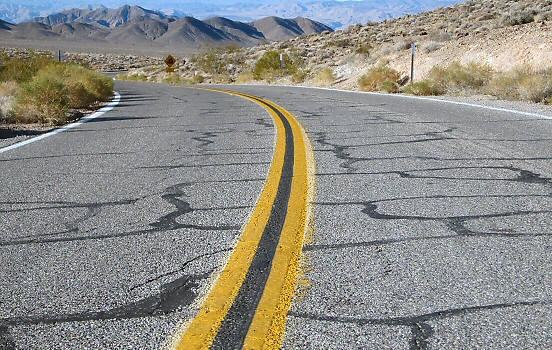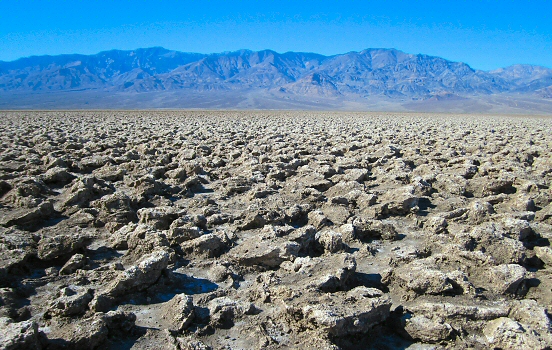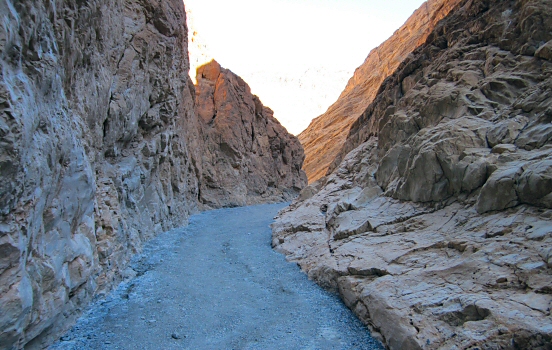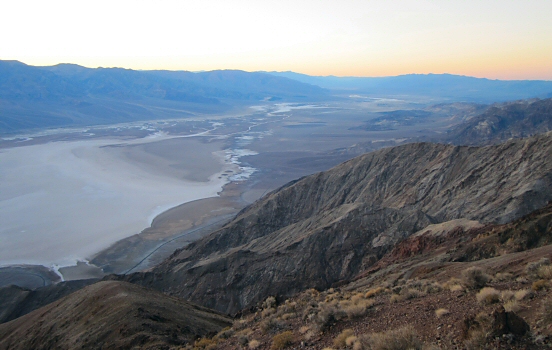There are places in the world that don’t care if you’re there. Death Valley is one of them. This infamous area of harsh territory is located in Eastern California, in the northern part of the Mojave Desert.
As I drove into Death Valley in the dark hours before sunrise, I silently pondered why the area got its name. It’s one of the hottest places on the planet and the record temperature of 56 degrees Celsius was measured here in 1913. As gold diggers struggled to cross the area in the 19th century, their fatal attempts made the valley earn its name.
At sunrise, we park the car and climb up the hills at Salsberry Pass. The view at 1010 meters is breathtaking, but as the sun rises swiftly, the chilling morning hours suddenly starts to transform into something much hotter. Not waiting for the Maillard reaction to start upon the skin, we race back to the car, turn the air condition to eleven and drives west through Jubilee Pass.
 Scorched road in Death Valley.
Scorched road in Death Valley.
The sun glares like a vengeful god, and the horizon wobbles under the heat. This isn’t a average scenic detour. It’s a punishing, merciless stretch of scorched rock and sand that dares anyone to keep going.
After a while we reach Badwater, where we walk on salt crystals at what first appeared to be a lake. At 86 meters below sea level, Badwater is as low as you can get in North America without digging. It’s a salt-crusted wasteland where nothing grows, nothing thrives, just endless white flats under a pitiless sky. Yet it has a strange beauty, a serenity found only in complete desolation.
“Well I’m so tired of driving but here comes the highway
Flowin’ from the clouds down to meet the sea
Ride with me Jesus so high on the mainline
Crimson sunsets and golden dawns
It’s the last time I’ll drive Death Valley”
— Mark Lanegan, Driving Death Valley Blues (2004)
The vistas are both beautiful and alien. We encounter the salt pan called Devil’s golf course, which could easily fit into any sci-fi movie as another planet. The names around here sound like warnings or the punchlines of cosmic jokes.
 Devil’s golf course.
Devil’s golf course.
This otherworldly character in combination with being close to the film industry of Los Angeles makes the desert a popular place for movie locations, such as Star Wars episode 4 which was filmed here in 1977.
In the area called Artist’s Palette we look for some of the places, such as the location where R2D2 is ambushed by Jawas and manage to find the exact site where their Sandcrawler was parked. It’s geological madness painted in pastels.
 Getting some lovely moments of shade at Mosaic Canyon.
Getting some lovely moments of shade at Mosaic Canyon.
There aren’t many cars around here in the desert, but unlike the main character Kowalski in 1971 movie Vanishing Point, I did my best to stay on the right side of the road and avoid trouble with the law.
The ultimate sunset experience proves to be from Dante’s View, where the entire valley is overlooked. This hill is infamous for being the place where Luke and Obi-Wan look down upon Mos Eisley.
 Dante’s View.
Dante’s View.
Another surreal place turns out to be Zabriskie Point, where the surrounding hills remind me of soft ice cream draped in the sunset colors. On this hill, the photos for the cover of U2 album Joshua Tree was taken by Anton Corbijn.
You don’t visit Death Valley for comfort. You go because it strips everything down. No distractions. No noise. Just you, the road, and the raw, unfiltered hostility of the earth. It’s a confrontation with silence. A middle finger to convenience. And somehow, that makes you feel more alive than a thousand tourist traps ever could.
I drive north and leave the valley of death, listening to Dead Can Dance in pitch-black surroundings.
360 photos

Comments
No comments yet.
Leave a reply